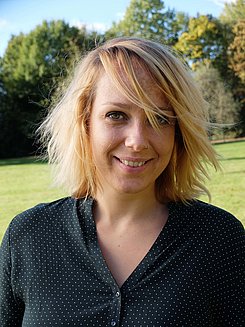Frau Anne Neuser
Allgemeine Geographie / Mensch-Umwelt-Forschung
Team
www.geographie.uni-wuppertal.deBiografie
Kurzbiographie
- Seit Januar 2017: Anstellung als wissenschaftliche Mitarbeiterin / Promotionsstudentin an der Berischen Universität Wuppertal, Fakultät für Human- und Sozialwissenschaften, Fachbereich Allgemeine Geographie / Mensch-Umwelt-Forschung
- Juni 2016 – Dezember 2016: Anstellung als Mitarbeiterin im Baugrundinstitut, Solingen
- Dezember 2015 – März 2016: Anstellung als wissenschaftliche Hilfskraft im Forschungszentrum Jülich
- Ende 2015: Abschluss M.Sc. Geographie (sehr gut, 84 %) Vertiefungsrichtung: Stadt- und Landschaftsökologie; Thema der Masterarbeit: Einfluss von Biokohle und Kompost auf die mikrobielle Atmung und Enzymaktivität in einem subtropischen Boden.
- August 2012: B.Sc. Geographie (gut, 79 %); Thema der Bachelorarbeit: Wirkung pyrogener, mit Abwassernachlauf und Phosphor angereicherter Biokohle in Böden.
- Oktober 2012 – September 2015: Wissenschaftliche Hilfskraft im Bereich Bodenkunde
- April 2010 – Dezember 2015: Studium an der Ruhr-Universität Bochum; Studienfach: Geographie: Schwerpunkt: Physische Geographie/Bodenkunde
- Oktober 2007 - September 2009: Studium an der Justus-Liebig-Universität in Gießen, Studienfach: Umwelt- und Ressourcenmanagement
- August 2006 - April 2007: Freiwilliges Ökologisches Jahr im Feriendorf Herbstein und beim Bioland-Reiterhof Oberwaider-Hof in Schotten (Hessen)
- Juni 2006: Abitur, Graf-Engelbert-Gymnasium Bochum
Titel und Abstract des Dissertationsprojektes
Challenges in using mid-infrared spectroscopy for the determination of soil physical, chemical, and biochemical properties on undisturbed soil samples
Diffuse reflectance infrared Fourier transform (DRIFT) spectroscopy in the mid-infrared range (MIR) has become an established analytical tool for quantitative and qualitative analysis of soil samples. The heterogeneity of soil requires sample preparation procedures to optimize the reproducibility and accuracy of the spectroscopic measurement. These procedures have not been standardized. Generally, soil is dried and finely ground before measurement to avoid reflections of surface water films and minimize the intra- and inter-particle variability, respectively. Additionally, the sample surface is levelled to a plain surface for an ideal reflection. However, these sample preparation techniques are limited to disturbed samples only. Thus, a potential DRIFT mapping of undisturbed soil samples requires an adjusted calibration to allow for an accurate prediction of soil properties.
In this study, we developed a method for calibrating the prediction of DRIFT spectra collected from undisturbed soil samples. In a first step, differences of spectral information measured from undisturbed and ground soil samples have been evaluated. Therefore, we record the DRIFT spectra of 120 German and 120 West-African (Ghana and Burkina Faso) chemically well characterized soils. DRIFT spectra of both, ground and sieved only soil samples are recorded and both calibrated against different physio-chemical soil properties, such as texture, CEC, organic carbon, pH, or iron oxides. In preliminary experiments, we found that spectra of sieved and ground sampled significantly differed in specific spectral regions representing clay minerals, as well as organic matter. It can be assumed that the prediction of surface related soil parameters, such as CEC, could be superior using sieved soil spectra, as grounding alters the surface structure of the soil.
In a further step, microtopgraphy effects on spectra quality from disturbed as well as undisturbed soil samples have been evaluated. Therefore, spectral information has been taken from two dimensional disturbed and undisturbed soil samples at a high spatial resolution of 2 mm. The spectra quality was significantly higher in the disturbed soils since microtopography was absent in these samples. Thus, a digital elevation model (DEM) will be constructed using close-range digital photogrammetry to correct for these topography effects of the DRIFT mapping data from undisturbed soil samples.
With this new method, there is a potential of imaging soil parameters on a microscale that can help considerably in locating and understanding soil processes on a small scale.
Neuigkeiten
Vortragstätigkeit
In Bearbeitung
Publikationen
In Bearbeitung
Sonstige wissenschaftliche Aktivitäten/Mitgliedschaften
In Bearbeitung
Sonstiges
M.Sc.

